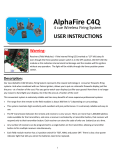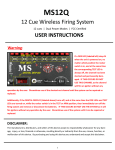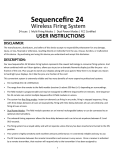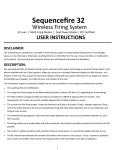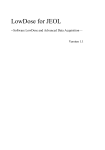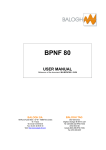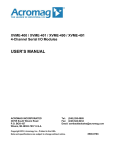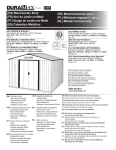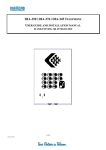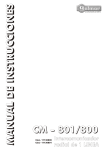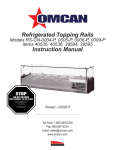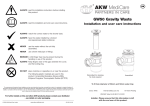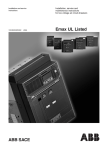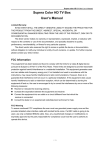Download AlphaFire C12QS - FiringSystems.us
Transcript
AlphaFire C12QS Wireless Firing System 12 cues | Dual Firing Modes | FCC Certified USER INSTRUCTIONS Warning: Receivers (Field Modules) - If the internal firing LED (marked as “10” left) stays lit even though the three-position power switch is in the OFF position, DO NOT USE the module as this indicates internal electrical damage and the module will fire igniters without any operation. The light will be visible through the three-position power switch. Description: Our new Alphafire C12QS Wireless Firing System is FCC Certified, and represents the newest technology in consumer fireworks firing systems. And when combined with our Falcon igniters, you can put on a dramatic fireworks display just like the pros - at a fraction of the cost. Plus you get to watch your displays just like your guests! Now there is no longer any reason to hand light your displays. Do it like the pros at a fraction of the cost! This convenient system is extremely reliable and has many benefits of more expensive professional systems: FCC Certified (FCC ID: YMUT10012LN, YMUT10012X) The range from the remote to the field modules is about 300 feet (+/-) depending on surroundings. This system maintains high sensitivity with excellent anti-jam performance. It is extremely reliable and easy to use. The RF transmission between the remote and receivers is very secure. There are more than 1,000,000 address codes available for the transmitters, and once a receiver is activated by a transmitter button, that receiver will respond only to that transmitter button press. Each receiver can store the code of only one button/cue at a time. Any number of receivers can be programmed to the button/cue of transmitter, allowing a transmitter button/ cue to fire multiple receivers simultaneously. Transmitters come with an on/off switch for added safety and security. You cannot inadvertently fire a cue with the remote power switch in the off position. Turn the remote power on only when ready to fire. 1 Each field module receiver has a 3-position switch for TEST, ARM, and power OFF. There is also a low power indicator light that tells you when the batteries need to be replaced. There are twelve (12) separate field modules. This elegant solution keeps your shoot site "truly" wireless. Each field module stands near the item being fired - no long wire runs! Igniters can utilize shorter lead wires and there is no need for extra extension wire which saves you money. Field modules are programmable - program any field module to any button of any Alphafire C12QS remote transmitter. Program all field modules to fire on one remote button, or two modules on one button or three, etc., allowing for totally flexible setup arrays. Dual firing modes: Each system include two (2) 12-button remotes. One remote fires receivers instantly with each button press. The second remote fires all of the receivers in timed interval sequence based upon the button pressed (0.1s,0 .2s,0 .3s,...0.9, 1.0s, 2.0s, or ALL) You can start with 12 cues and upgrade to 24, 36, 48, etc. anytime just by adding more field modules and remotes. All field modules are interchangeable. If any field module should fail after the 1 year warranty period the cost of repair is only the cost of one module. Using a remote firing system like our Alphafire C12QS is much safer than lighting by hand. The Alphafire C12QS is a versatile and economical answer to a vast matrix of consumer wireless firing demands. Transmitter (Remote) A: Model: TCF100-12LN (FCC Certified) FCC ID: YMUT10012LN Power: 23A 12V battery (not included) Buttons: 12 buttons labeled 1 through 12 Transmitter A is used for instant on-demand firing. The field module(s) assigned to each button will fire immediately when the button is pressed. Transmitter has an ON/OFF switch for added safety. Unit will not operate when in the OFF position, thereby eliminating the risk of an inadvertent button press. 2 Transmitter (Remote) B: Model: TCF100-12LNX (FCC Certified) FCC ID: YMUT10012X Power: 23A 12V battery (not included) Buttons: 12 buttons labeled 0.01 through 1.0, 2.0, and ALL Transmitter B is used for timed sequence firing. The press of any one button will fire all of the receivers (field modules) in sequential order with the specified amount of time delay between cues. Pressing the ALL button will fire all cues at the same time. (Example: Pressing the 0.9 button will fire all twelve cues in sequential order with 0.9 second delay between cues.) Transmitter has an ON/OFF switch for added safety. Unit will not operate when in the OFF position, thereby eliminating the risk of an inadvertent button press. Receivers (Field Modules): Model: AlphaFire RF1A (FCC certified) Field Modules: 12 total (each containing 1 cue) Power: 4x AAA Battery Firing Current: > 750 mA Test Current: < 10mA Size: 55 mm x 50.5 mm x 40 mm Firing Capacity: 1 Falcon Igniter per Module Legend: 1 – Antenna: retractable and foldable 2 – Power / Low Power LED: Normally the LED is in a steady lit condition when the power switch is in the FIRE position. The LED blinks when the batteries are low. 3 – Test LED: When the exterior circuit is continuous the LED will be on. When the exterior circuit is broken the LED will be off. 4 – Three-Position Switch: TEST, ARM, OFF 5 - LEARN button used to place the unit in LEARN mode. This button will only work when the three-position switch is in the FIRE position. 6 – SIGNAL LED. See section below regarding the LEARN procedure. Also, LED will light when a transmitter signal is received. 7 – Quick Connect Terminals: used for connecting an igniter to the module. It does not matter which wire from the igniter goes in each terminal. 3 Before Use: Install batteries: Before using your new firing system you will need to install one 23A 12V battery in each remote transmitter and 4 AAA batteries in each field module receiver. You will need a total of (2) 23A 12V batteries and (48) AAA batteries. LEARN procedure: You will also need to go through the LEARN procedure for each field module receiver before the receivers will take commands from your remotes. Transmitter A must be LEARNED by the receivers before moving on to transmitter B, otherwise transmitter B will be invalid. LEARN Procedure for Transmitter A : (follow this procedure for each field module receiver) On the field module, shift the three-position switch to the ARM position. On the field module, press and hold the LEARN button for three seconds until the SIGNAL LED lights up, then release the LEARN button. Immediately (within 3 seconds) press a button on remote transmitter A that you want assigned to the field module receiver. The SIGNAL LED on the receiver will blink twice. The receiver LEARN process is now complete and the field module receiver is now assigned to the transmitter button selected. Confirm successful programming by pressing the remote transmitter button assigned above and watching for the SIGNAL LED to light up on the field module. When transmitter A has been LEARNED by all of the receivers then it is time to move on to transmitter B. LEARN Procedure for Transmitter B : (follow this procedure for each field module receiver) On the field module, shift the three-position switch to the ARM position. On the field module, press and hold the LEARN button for three seconds until the SIGNAL LED lights up, then release the LEARN button. Immediately (within 3 seconds) press any button on remote transmitter B. It doesn't matter which button on transmitter B you press. The SIGNAL LED on the receiver will blink twice. The receiver LEARN process is now complete and the field module receiver is programmed to work with remote transmitter B. You don’t need to have all buttons of transmitter B learned by the receivers. Through LEARNING transmitter A, receivers will learn which cue number (remote button) they are assigned to. Through LEARNING transmitter B, receivers will learn time intervals between cue firing. 4 CLEAR Procedure: To clear a field module receiver of all previously learned remote codes, shift the three-position switch to the ARM position. Press the LEARN button and do not release for a least six (6)seconds and until the SIGNAL LED blinks three (3) times. After the SIGNAL LED blinks three (3) times then all previously leaned codes have been cleared from memory. WARNING: Only when no fireworks are connected to the firing system may the LEARN or CLEAR procedure be performed. Never perform these procedures when fireworks are connected. Accidental ignition may occur. How to Use: TEST Igniter Circuit: When an exterior circuit is connected (igniter connected) to a field module receiver, shift the three-position switch to the TEST position. If the TEST LED turns on then your external circuit is good. If the TEST LED does not light up then your external circuit is broken and the igniter will not fire. Check your circuit and replace the igniter if necessary. Firing Procedure: After your exterior circuit has tested as being good, follow one of the following procedures. FIRE Procedure for Transmitter A : Individual on-demand cue firing On the field module, shift the three-position switch to the ARM position. Press the appropriate button on transmitter A to fire the corresponding field module. The SIGNAL LED on the corresponding field module will blink once, indicating a good signal has been received, and the firing current will be sent to the external circuit. NOTE: In FIRE status, once the receiver has been sent the firing command, it cannot be activated again for five (5) seconds. FIRE Procedure for Transmitter B : Timed sequence firing of all cues On the field modules, make sure the three-position switches are in the ARM position. Press a button on transmitter B that gives the desired time delay between cues. Or press the ALL button to fire all cues at the same time. The SIGNAL LED on the corresponding field modules will blink once, indicating a good signal has been received, and the firing current will be sent to the external circuit. NOTE: In FIRE status, once the receiver has been sent the firing command, it cannot be activated again for five (5) seconds. Example of sequential firing using transmitter B: Press the 0.2 button results in the following elapsed firing times... Cue 1 Cue 2 Cue 3 Cue 4 Cue 5 Cue 6 Cue 7 Cue 8 Cue 9 Cue 10 Cue 11 Cue 12 0 sec .2 sec .4 sec .6 sec .8 sec 1.0 sec 1.2 sec 1.4 sec 1.6 sec 1.8 sec 2.0 sec 2.2 sec 5 SAFETY IS OUR MAIN PRIORITY: REMEMBER, SAFETY IS OUR PRIMARY CONCERN WHEN WORKING WITH FIREWORKS. REMOTE FIRING SYSTEMS CAN ADD AN ADDITIONAL LEVEL OF SAFETY TO IGNITING FIREWORKS, BUT THE RISKS OF ACCIDENTAL IGNITION STILL REMAIN EVEN WITH THE REMOTE FIRING SYSTEMS USE. PLEASE, MAKE SURE ALL FIELD MODULE POWER SWITCHES ARE IN THE OFF POSITION RIGHT UP UNTIL THE TIME YOUR DISPLAY IS ABOUT TO BEGIN. THIS NOT ONLY SAVES ON BATTERIES, BUT HELPS TO PREVENT ACCIDENTAL IGNITION FROM AN INADVERTENT BUTTON PRESS. PLEASE REVIEW OUR COMMON SENSE SAFETY GUIDELINES LOCATED AT: http://www.fireworks.us DISCLAIMER: The manufacturers, distributors, and sellers of this device accept no responsibility whatsoever for any damage, injury, or loss, financial or otherwise, resulting directly or indirectly from the use, misuse, function, or malfunction of this device. By purchasing and using this device you understand and accept this disclaimer. 6 Quantum Fireworks LLC www.Fireworks.us www.FiringSystems.us Email: [email protected] 7







